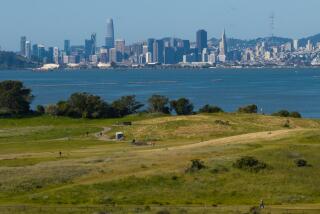Study Shows Low Risk for Proposed L.A. Incinerator
- Share via
The huge trash incinerator that many city officials want to build in South-Central Los Angeles poses less risk to residents--though not necessarily to politicians--than any other such facility in the country, according to a scientific evaluation released Wednesday.
The number of estimated potential cancer cases was so far below other studies, however, that the results were greeted with skepticism as soon as they were released.
State air quality officials required the study of health risks before deciding whether to license the proposed Los Angeles City Energy Recovery (Lancer) project, which has turned into a heated political issue with the potential to sway voters in the June 2 City Council runoff elections. Council President Pat Russell, a past backer of Lancer, is opposed by an active Lancer critic, Ruth Galanter, and has the most to lose.
Mayor Tom Bradley and some members of the City Council have said they would withhold their final support for Lancer until assured that it would be safe, although they have already approved more than $10 million for the project, some of it before opposition arose last year.
The study, conducted by Allan H. Smith, a professor at the University of California, Berkeley, evaluated the safety of trash burning by estimating the cancer risk for people exposed to emissions from the plant for 70 years. Such plants blow dioxins and other dangerous substances out their smokestacks, and the cancer risk per million people exposed is a standard method scientists use to compare the risks from plants.
Smith, president of a company called Health Risk Associates, used tests at a similar facility in Wurzburg, West Germany, to conclude that the Los Angeles incinerator would pose a risk of 0.1 added cancer cases.
Smith said it was the lowest risk he had encountered in the several studies he knows of elsewhere in the country, where the number has ranged as high as 35 added cancer cases per million people.
Smith attributed the low figure in part to a crucial, and potentially controversial, decision to assume that the Los Angeles plant would spew the same amount of dioxins, toxic metals and other harmful pollutants as the German facility. The New Jersey company that holds the contract to build Lancer, Ogden-Martin Corp., also designed the German plant, and company officials said they can be expected to perform about the same.
Independent experts have said the content of the trash, however, especially the percentage of plastic bags and other “chlorinated plastics” mixed in with the paper and other garbage, can make a big difference in how many pollutants come out the stack. Smith said he is not aware how German trash compares with Los Angeles trash.
Critics have also said it would be more scientific to judge the Los Angeles plant against an average of several other incinerators, not just against the German plant, where lower-than-normal dioxin emissions were measured.
Smith said the lower risk expected from Lancer is also attributable to changes in a computer program that officials of the state Air Resources Board approved.
“Basically, we would not expect to find any additional cancer cases from emissions from this plant,” Smith said.
Barry Commoner, noted environmentalist in New York and vocal critic of trash burning, said that he needs several days to review the study, but that he is skeptical of such a low risk figure. “That’s a record,” Commoner said. “Most of them are higher, considerably higher.”
Opponents in South-Central Los Angeles and elsewhere in the city said they expected the report to be favorable to the project’s chances, and they asked the city for more time to study the results. City officials have said the study will be reviewed, with public hearings, during the next 60 days, then the City Council will be asked to decide if the risk is acceptable.
‘Too Technical’
“The document is too long and too technical for a layman to critique on short notice,” said Laura Lake, a UCLA professor and a spokeswoman for opponents of the Lancer plan.
Methods used to conduct the study were judged acceptable by a “peer review committee” of doctors, professors and scientists around the country chosen by the City Council. That committee will review the results and make a statement about the scientific validity of the findings.
In studies elsewhere, the cancer risk has been revised upward after critics have attacked the original methods used to estimate the dangers. W. John Phillips, vice president of Ogden-Martin, said he would not be surprised if the figure rose slightly, but he said the company expects final City Council approval this summer.
The city has purchased and cleared a 13-acre site at 41st Street and Alameda Avenue for the plant.
More to Read
Sign up for Essential California
The most important California stories and recommendations in your inbox every morning.
You may occasionally receive promotional content from the Los Angeles Times.










